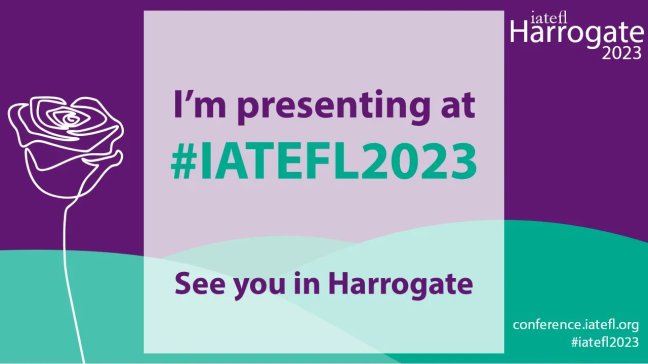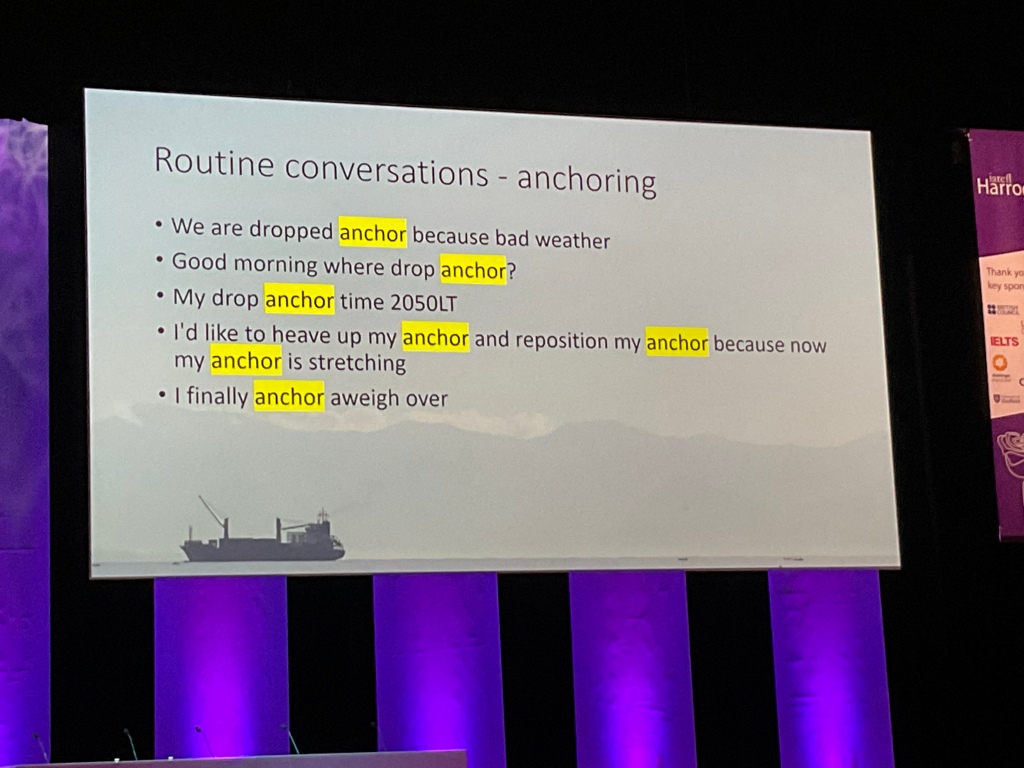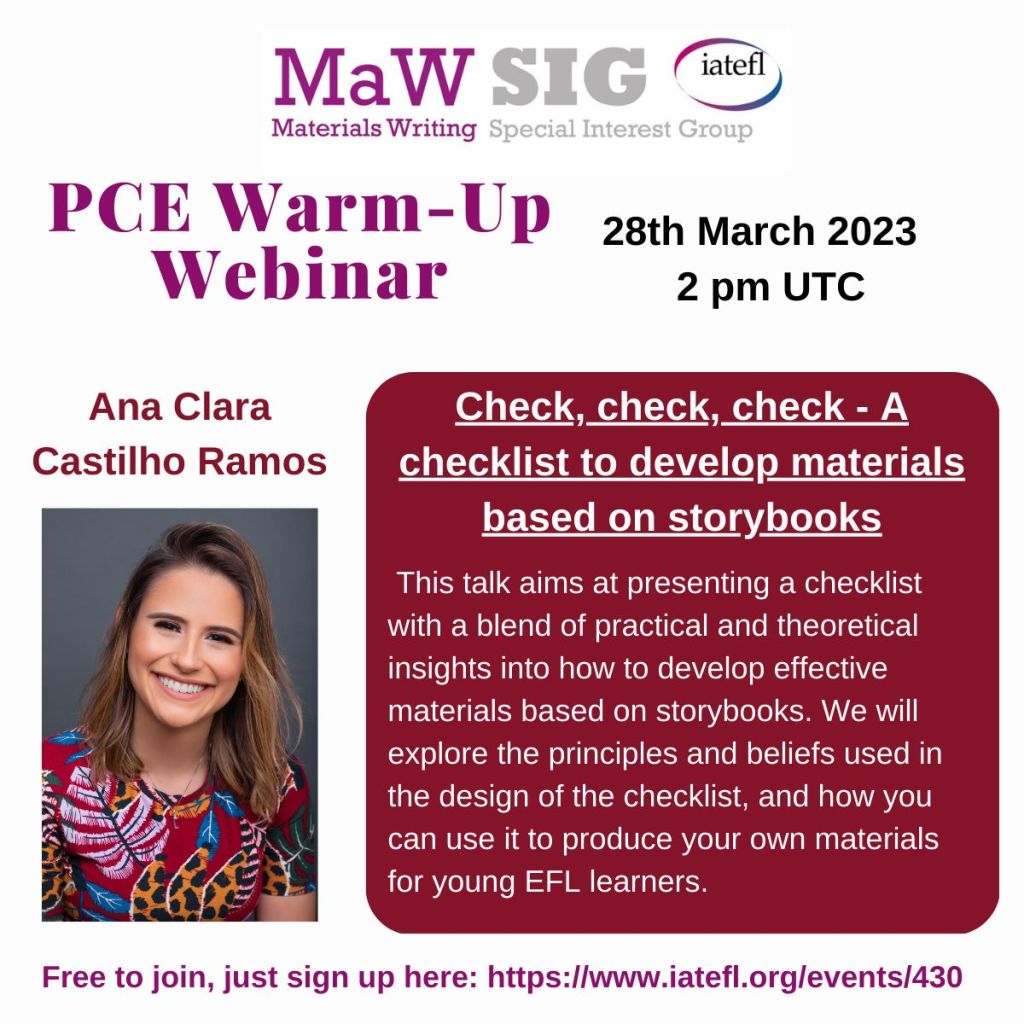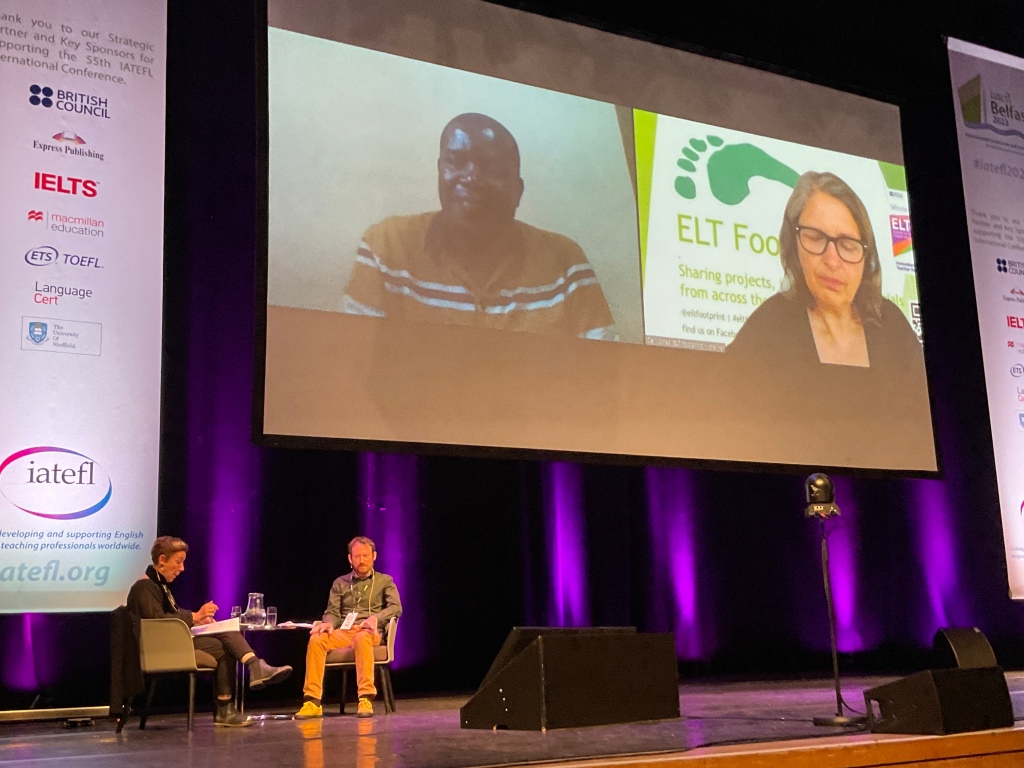I finally made it to IATEFL Brighton and was able to enjoy talks on the final day 🙂 I spent most of the rest of my 24 hours at the conference chatting to people – one of the things I most enjoy about being together with friends and colleagues from around the world!
Rose’s talk is about criticality as an analysis of power. You can watch the plenary yourself on YouTube after 8pm today [I’ll add the link later].
Language, power and education
There are different kinds of power according to Waring:
- Political power
- Personal power: the individual power we have based on the roles we play in society: a parent, employers, etc.
- Social group power: associated to class, gender, etc. This is about the statistical likelihood of having power according to your group, even if you as an individual belonging to that group don’t have that power.
Power is fluid and dynamic. Anywhere there is a social relationship, there is power, including schools. Schools are not politically neutral, and education does not take place in a political vacuum. Watch the video to see the range of headlines associated to power and education.
Everything we do in the classroom is value-laden. This can contribute to reinforcing the status quo or seeking to challenge it. Failing to act, the things we overlook and ignore, also reflects our values.
Paulo Freire argued that education can be transformative in its nature, in Pedagogy of the Oppressed.
One of the ways in which change happens is through language use. Power is embedded in language.
Rose gave the example of this headline:
I teach in secret, defying the Taliban ban and fighting despair
A first-person singular pronoun emphasises the isolation of the teacher who wrote this opinion post onAlJazeera .
The assonance of ‘teach’ in ‘secret’ emphasises ____
Emotive language and figurative language position the writer as a fighter and seek to influence the reader. There’s an -ing with a positive act of resistance.
Other examples are the rule of three – they’re supposedly more memorable, and have more impact. This can be three words, three ideas.
Here are some examples of languages Rose overheard at IATEFL which reveal a relationship of power through the use of language:
- Sir David Crystal…big boots to fill! > ‘Sir’ as a marker of status
- Delegates are asked to follow the IATEFL ethos of respectral exchange, of focusing on topics related to ELT and of being an inclusive and supportive community. > passive obscures the agent
- An example of interrupting or overlapping speech > Dominant participants in a conversation take the lead, choose the topics, etc. Less dominant partners follow the lead, don’t get to choose the topics, etc.
- Put it on the tab! > imperatives for giving orders, people with more power giving orders to people with relatively less power
Language teachers do more than just teacher the language. Language can be emancipatory.
Critical literacy
Concepts of this are influenced by the Frankfurt School in the 1920s, and Freire from the 1940s onwards. The way we read any text is mediated by our day-to-day lived experiences. Literacy has moved from being seen as a concrete set of skills towards a perspective for what we do with literacy.
Research on critical literacy in ELT is quite rare. ‘Taking on Critical Literacy: The Journey of Newcomers and Novices’ is the study Rose focussed on, and Lewison’s framework is how she’s referring to it in her talk.
What is it? Lewison et al (2002) say it includes:
- Disrupting the commonplace
- Interrogating multiple viewpoints
- Focusing on socio-political issues
- Taking action and promoting social justice
Disrupting the commonplace

Asking: ‘How is language used to keep things as they are?’ We need to be able to identify the commonplace or the everyday: the assumptions we make that we believe to be self-evidently true. Narratives like ‘The pursuit of more and more wealth will make us happy.’ Or ‘Your wedding day should be the best day of our lives.’
Interrogating multiple viewpoints

Exploring texts from our own viewpoints and those of others, noticing which viewpoints are missing. This can be applied to visuals as well.
It prompts us to question written, spoken and visual texts and to go beyond words or visuals to read texts as situated within wider societal discourses.
Living, non-human, voiceless beings, plants, animals, is also part of this.
Focusing on the socio-political

Education often takes place without any acknowledgement of the political side of the education system we are in. It’s about stepping outside our own context and understanding concepts like ‘linguistic gatekeeping’ – controlling and limiting access to resources or spaces through the use of language. Language can be used as a gatekeeper for inclusion or exclusion.
It involves investigating and critiquing how language is used to create and maintain unequal systems.
Taking action for social justice
This is often considered the definition of critical literacy, but the authors say you need the understanding of the first three parts of the framework to be able to do this.

Critical literacy shouldn’t just be a one-off event, it should be an ongoing stance to question power relations. The way we communicate has changed hugely in this century, and we’re only just catching up. We’re exposed to a much wider range of genres and sources of texts, including now the inclusion of the source of generative AI. We need to be able to read texts critically to manage our understanding of this information.
How can we apply critical literacy to language education?
The framework can also be applied to management, recruitment, conferences and more, not just what happens in the classroom.
Practice
This is Rose’s framework, starting with practice in the middle:

The idea that there’s ’one best method’ for teaching and learning has long been questioned. One of the main critiques of the idea of methods is that it privileges ‘expert knowledge’ overwhelmingly located in the native speaker West, and pushes aside teacher knowledge. Now we’ve generally accepted that there is no one best method. Instead the search for the best method, it could be argued that we’ve replaced this with the search for the coursebook. What the majority of teachers teach and how they teach is now determined by coursebooks, more than any other factor.
This means an ability to critique and deconstruct our teaching materials is a key part of our understanding. We also need to critique dominant understandings of materials creation, such as the idea that PARSNIPS in creating materials (Politics, etc). Who decides what is taboo? Who decides what is ‘controversial’? We should stop treating them like this, and start calling them ‘critical’ instead: it’s critically important that learners can write and talk about these ideas. We can take action by supplementing or changing our course materials so that learners can learn about these topics and learn to talk about these areas. Moving beyond just ‘safe spaces’ to classrooms as ‘brave spaces’. Another key area is the idea that teaching and learning materials are value-neutral, which is definitely not true. We need to be able to identify hidden curriculums in materials, working with our learners to do this: who is included? Who is excluded? What relationships are included and excluded? How are materials constructed and situated? A third narrative connected to materials which we know isn’t true: ‘Native’ speakers make the best models of English. Include a much wider range of speakers in our materials. Possible sources, all of which are freely available, including The Hands Up Project podcast:

Assessment
Do our learners have any agency in when, how often, and how they are tested? Could testing could be made more democratic? Can learners choose more about who assesses them (and more – see the video)? Do our assessments acknowledge that learners might have different life experiences (like being able to go on holiday, spend time with family, etc.).
Interactions
‘Students as teachers’ and ‘teachers as students’ can eliminate the power dynamic between teachers and students, according to Freire. To what extent can we learn from our learners?
Consider how your classroom management reinforces power dynamics. How much agency do your learners have about how and when they study and the rules they are expected to adhere to?
Does our teacher talk encourage enquiry and questioning? Whose voices are heard most in our classroom apart from our own? In which situations are they encouraged to speak? Do we invite participation from female and male speakers equally? Do we help learners to realise that their voice has value?
Institution

Teacher training
Taking a critical approach to teacher education doesn’t mean adding content to a packed timetable. It can be woven into the development we do. It should be seen as a way to encourage teachers to question the training materials we use.
Are we ensuring that our reading lists showcase expertise from a range of backgrounds and teachers working in a range of different backgrounds?
Our own practice as trainers should be a model of showing how to incorporate voices from different participants. We can share articles which critique mainstream teaching practices which teachers learn.
Management
Recruitment and native speakerism – we need to call out native speakerism wherever and wherever we can. This is the responsibility of all of us. If you are financially able to, boycott schools which only want native speaker teachers, letting them know why you have done this. State clearly that you celebrate diversity including linguistic diversity when recruiting. Share and discuss policies with students, staff and parents that address native speakerism.
Teacher pay and working conditions: poor wages, precarious contracts, expectations of unpaid labour, a lack of pay transparency. Talk to each other. Share and compare rates of pay. Do this within and between schools. If you can, join a union. If you employ teachers, invest in us. Advertise a clear, transparent pay structure that takes account of qualifications and experience. Pay us for planning, admin and CPD, not just lessons. Put us on permanent contracts on a fair wage so we can afford to get a mortgage and start a family. Show your teachers appreciation: we don’t want to go to work to feel burnt out, devalued and unappreciated.
Field

Critical questions
[There were many more which I missed – please watch the plenary as they are all so important!]
To what extent is English now just another ‘product’? What is the impact of the commodification of English on what we do? W
Whose English is it, anyway? Exactly how much clout do some of these powerful organisations have? How inclusive is international education and research when English is the dominant medium of education?
How can we de-center English language teaching? How can we diminish the feelings of insiders and outsiders?
Who benefits from the ELT industry in its current form? What does the use of English mean for other communities? In what ways have some of these bodies contributed to some of the problems they now purport to be solving?
The full framework

As a field, it does seem we are now questioning power more.
Education is the most powerful weapon you can use to change the world.
Nelson Mandela
Rose reminds us of the unique power of language education to change the world.
























































































































































































































































































































































